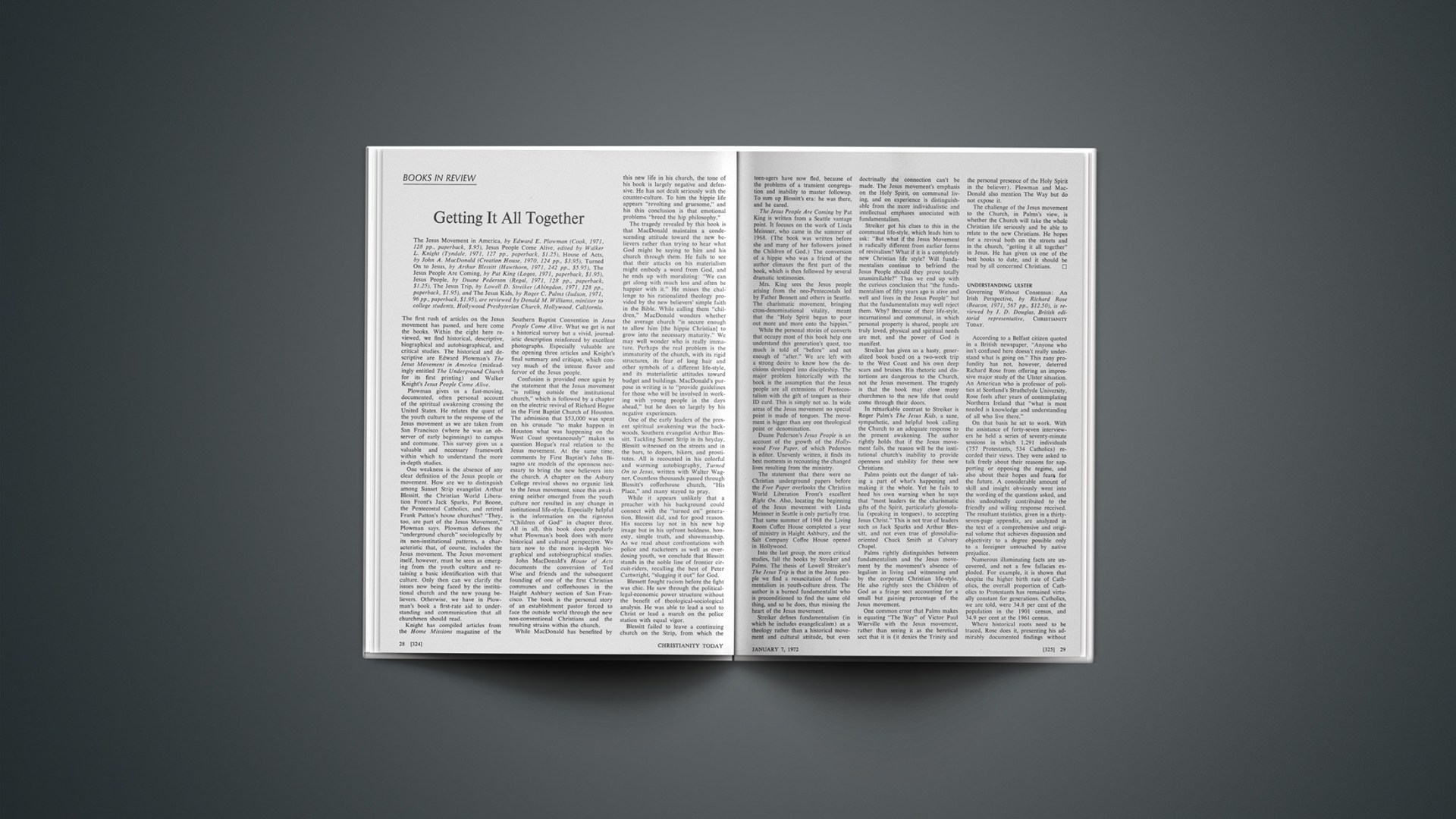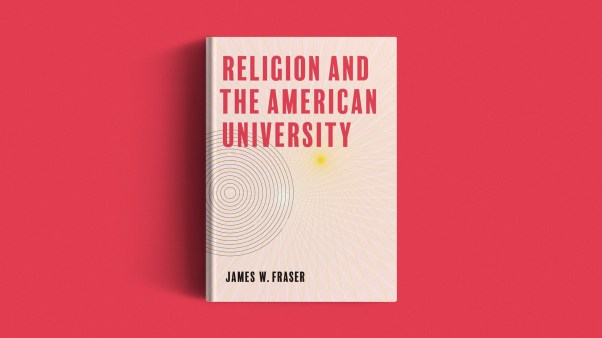Getting It All Together
The Jesus Movement in America, by Edward E. Plowman (Cook, 1971, 128 pp., paperback, $.95), Jesus People Come Alive, edited by Walker L. Knight (Tyndale, 1971, 127 pp., paperback, $1.25), House of Acts, by John A. MacDonald (Creation House, 1970, 124 pp., $3.95), Turned On to Jesus, by Arthur Blessitt (Hawthorn, 1971, 242 pp., $5.95), The Jesus People Are Coming, by Pat King (Logos, 1971, paperback, $1.95), Jesus People, by Duane Pederson (Regal, 1971, 128 pp., paperback, $1.25), The Jesus Trip, by Lowell D. Streiker (Abingdon, 1971, 128 pp., paperback, $1.95), and The Jesus Kids, by Roger C. Palms (Judson, 1971, 96 pp., paperback, $1.95), are reviewed by Donald M. Williams, minister to college students, Hollywood Presbyterian Church, Hollywood, California.
The first rush of articles on the Jesus movement has passed, and here come the books. Within the eight here reviewed, we find historical, descriptive, biographical and autobiographical, and critical studies. The historical and descriptive are Edward Plowman’s The Jesus Movement in America (misleadingly entitled The Underground Church for its first printing) and Walker Knight’s Jesus People Come Alive.
Plowman gives us a fast-moving, documented, often personal account of the spiritual awakening crossing the United States. He relates the quest of the youth culture to the response of the Jesus movement as we are taken from San Francisco (where he was an observer of early beginnings) to campus and commune. This survey gives us a valuable and necessary framework within which to understand the more in-depth studies.
One weakness is the absence of any clear definition of the Jesus people or movement. How are we to distinguish among Sunset Strip evangelist Arthur Blessitt, the Christian World Liberation Front’s Jack Sparks, Pat Boone, the Pentecostal Catholics, and retired Frank Patton’s house churches? “They, too, are part of the Jesus Movement,” Plowman says. Plowman defines the “underground church” sociologically by its non-institutional patterns, a characteristic that, of course, includes the Jesus movement. The Jesus movement itself, however, must be seen as emerging from the youth culture and retaining a basic identification with that culture. Only then can we clarify the issues now being faced by the institutional church and the new young believers. Otherwise, we have in Plowman’s book a first-rate aid to understanding and communication that all churchmen should read.
Knight has compiled articles from the Home Missions magazine of the Southern Baptist Convention in Jesus People Come Alive. What we get is not a historical survey but a vivid, journalistic description reinforced by excellent photographs. Especially valuable are the opening three articles and Knight’s final summary and critique, which convey much of the intense flavor and fervor of the Jesus people.
Confusion is provided once again by the statement that the Jesus movement “is rolling outside the institutional church,” which is followed by a chapter on the electric revival of Richard Hogue in the First Baptist Church of Houston. The admission that $53,000 was spent on his crusade “to make happen in Houston what was happening on the West Coast spontaneously” makes us question Hogue’s real relation to the Jesus movement. At the same time, comments by First Baptist’s John Bisagno are models of the openness necessary to bring the new believers into the church. A chapter on the Asbury College revival shows no organic link to the Jesus movement, since this awakening neither emerged from the youth culture nor resulted in any change in institutional life-style. Especially helpful is the information on the rigorous “Children of God” in chapter three. All in all, this book does popularly what Plowman’s book does with more historical and cultural perspective. We turn now to the more in-depth biographical and autobiographical studies.
John MacDonald’s House of Acts documents the conversion of Ted Wise and friends and the subsequent founding of one of the first Christian communes and coffeehouses in the Haight Ashbury section of San Francisco. The book is the personal story of an establishment pastor forced to face the outside world through the new non-conventional Christians and the resulting strains within the church.
While MacDonald has benefited by this new life in his church, the tone of his book is largely negative and defensive. He has not dealt seriously with the counter-culture. To him the hippie life appears “revolting and gruesome,” and his thin conclusion is that emotional problems “breed the hip philosophy.”
The tragedy revealed by this book is that MacDonald maintains a condescending attitude toward the new believers rather than trying to hear what God might be saying to him and his church through them. He fails to see that their attacks on his materialism might embody a word from God, and he ends up with moralizing: “We can get along with much less and often be happier with it.” He misses the challenge to his rationalized theology provided by the new believers’ simple faith in the Bible. While calling them “children,” MacDonald wonders whether the average church “is secure enough to allow him [the hippie Christian] to grow into the necessary maturity.” We may well wonder who is really immature. Perhaps the real problem is the immaturity of the church, with its rigid structures, its fear of long hair and other symbols of a different life-style, and its materialistic attitudes toward budget and buildings. MacDonald’s purpose in writing is to “provide guidelines for those who will be involved in working with young people in the days ahead,” but he does so largely by his negative experiences.
One of the early leaders of the present spiritual awakening was the backwoods, Southern evangelist Arthur Blessitt. Tackling Sunset Strip in its heyday, Blessitt witnessed on the streets and in the bars, to dopers, bikers, and prostitutes. All is recounted in his colorful and warming autobiography, Turned On to Jesus, written with Walter Wagner. Countless thousands passed through Blessitt’s coffeehouse church, “His Place,” and many stayed to pray.
While it appears unlikely that a preacher with his background could connect with the “turned on” generation, Blessitt did, and for good reason. His success lay not in his new hip image but in his upfront boldness, honesty, simple truth, and showmanship. As we read about confrontations with police and racketeers as well as overdosing youth, we conclude that Blessitt stands in the noble line of frontier circuit-riders, recalling the best of Peter Cartwright, “slugging it out” for God.
Blessett fought racism before the fight was chic. He saw through the political-legal-economic power structure without the benefit of theological-sociological analysis. He was able to lead a soul to Christ or lead a march on the police station with equal vigor.
Blessitt failed to leave a continuing church on the Strip, from which the teen-agers have now fled, because of the problems of a transient congregation and inability to master followup. To sum up Blessitt’s era: he was there, and he cared.
The Jesus People Are Coming by Pat King is written from a Seattle vantage point. It focuses on the work of Linda Meissner, who came in the summer of 1968. (The book was written before she and many of her followers joined the Children of God.) The conversion of a hippie who was a friend of the author climaxes the first part of the book, which is then followed by several dramatic testimonies.
Mrs. King sees the Jesus people arising from the neo-Pentecostals led by Father Bennett and others in Seattle. The charismatic movement, bringing cross-denominational vitality, meant that the “Holy Spirit began to pour out more and more onto the hippies.”
While the personal stories of converts that occupy most of this book help one understand this generation’s quest, too much is told of “before” and not enough of “after.” We are left with a strong desire to know how the decisions developed into discipleship. The major problem historically with the book is the assumption that the Jesus people are all extensions of Pentecostalism with the gift of tongues as their ID card. This is simply not so. In wide areas of the Jesus movement no special point is made of tongues. The movement is bigger than any one theological point or denomination.
Duane Pederson’s Jesus People is an account of the growth of the Hollywood Free Paper, of which Pederson is editor. Unevenly written, it finds its best moments in recounting the changed lives resulting from the ministry.
The statement that there were no Christian underground papers before the Free Paper overlooks the Christian World Liberation Front’s excellent Right On. Also, locating the beginning of the Jesus movement with Linda Meissner in Seattle is only partially true. That same summer of 1968 the Living Room Coffee House completed a year of ministry in Haight Ashbury, and the Salt Company Coffee House opened in Hollywood.
Into the last group, the more critical studies, fall the books by Streiker and Palms. The thesis of Lowell Streiker’s The Jesus Trip is that in the Jesus people we find a resuscitation of fundamentalism in youth-culture dress. The author is a burned fundamentalist who is preconditioned to find the same old thing, and so he does, thus missing the heart of the Jesus movement.
Streiker defines fundamentalism (in which he includes evangelicalism) as a theology rather than a historical movement and cultural attitude, but even doctrinally the connection can’t be made. The Jesus movement’s emphasis on the Holy Spirit, on communal living, and on experience is distinguishable from the more individualistic and intellectual emphases associated with fundamentalism.
Streiker got his clues to this in the communal life-style, which leads him to ask: “But what if the Jesus Movement is radically different from earlier forms of revivalism? What if it is a completely new Christian life style? Will fundamentalists continue to befriend the Jesus People should they prove totally unassimilable?” Thus we end up with the curious conclusion that “the fundamentalism of fifty years ago is alive and well and lives in the Jesus People” but that the fundamentalists may well reject them. Why? Because of their life-style, incarnational and communal, in which personal property is shared, people are truly loved, physical and spiritual needs are met, and the power of God is manifest.
Streiker has given us a hasty, generalized book based on a two-week trip to the West Coast and his own deep scars and bruises. His rhetoric and distortions are dangerous to the Church, not the Jesus movement. The tragedy is that the book may close many churchmen to the new life that could come through their doors.
In remarkable contrast to Streiker is Roger Palm’s The Jesus Kids, a sane, sympathetic, and helpful book calling the Church to an adequate response to the present awakening. The author rightly holds that if the Jesus movement fails, the reason will be the institutional church’s inability to provide openness and stability for these new Christians.
Palms points out the danger of taking a part of what’s happening and making it the whole. Yet he fails to heed his own warning when he says that “most leaders tie the charismatic gifts of the Spirit, particularly glossolalia (speaking in tongues), to accepting Jesus Christ.” This is not true of leaders such as Jack Sparks and Arthur Blessitt, and not even true of glossolalia-oriented Chuck Smith at Calvary Chapel.
Palms rightly distinguishes between fundamentalism and the Jesus movement by the movement’s absence of legalism in living and witnessing and by the corporate Christian life-style. He also rightly sees the Children of God as a fringe sect accounting for a small but gaining percentage of the Jesus movement.
One common error that Palms makes is equating “The Way” of Victor Paul Wierville with the Jesus movement, rather than seeing it as the heretical sect that it is (it denies the Trinity and the personal presence of the Holy Spirit in the believer). Plowman and MacDonald also mention The Way but do not expose it.
The challenge of the Jesus movement to the Church, in Palms’s view, is whether the Church will take the whole Christian life seriously and be able to relate to the new Christians. He hopes for a revival both on the streets and in the church, “getting it all together” in Jesus. He has given us one of the best books to date, and it should be read by all concerned Christians. □
Understanding Ulster
Governing Without Consensus: An Irish Perspective, by Richard Rose (Beacon, 1971, 567 pp., $12.50), is reviewed by J. D. Douglas, British editorial representative, CHRISTIANITY TODAY.
According to a Belfast citizen quoted in a British newspaper, “Anyone who isn’t confused here doesn’t really understand what is going on.” This zany profundity has not, however, deterred Richard Rose from offering an impressive major study of the Ulster situation. An American who is professor of politics at Scotland’s Strathclyde University, Rose feels after years of contemplating Northern Ireland that “what is most needed is knowledge and understanding of all who live there.”
On that basis he set to work. With the assistance of forty-seven interviewers he held a series of seventy-minute sessions in which 1,291 individuals (757 Protestants, 534 Catholics) recorded their views. They were asked to talk freely about their reasons for supporting or opposing the regime, and also about their hopes and fears for the future. A considerable amount of skill and insight obviously went into the wording of the questions asked, and this undoubtedly contributed to the friendly and willing response received. The resultant statistics, given in a thirty-seven-page appendix, are analyzed in the text of a comprehensive and original volume that achieves dispassion and objectivity to a degree possible only to a foreigner untouched by native prejudice.
Numerous illuminating facts are uncovered, and not a few fallacies exploded. For example, it is shown that despite the higher birth rate of Catholics, the overall proportion of Catholics to Protestants has remained virtually constant for generations. Catholics, we are told, were 34.8 per cent of the population in the 1901 census, and 34.9 per cent at the 1961 census.
Where historical roots need to be traced, Rose does it, presenting his admirably documented findings without the inhibiting need to look over his shoulder. It’s all here: economic differences, housing, B-Specials, relationship to Westminster, civil rights, Dublin attitudes, political parties, disputed border, British Army intervention, IRA, Orange Order, a chapter entitled “Two Bodies in Christ,” and much more.
The closing section ventures a remarkable and thought-provoking comparison of American history, with reference to its black population, and the history of Northern Ireland. Altogether, this book is a lucid eye-opener that, unlike Senator Edward Kennedy, offers no slick solutions but realizes that the two things required in the province are time and good will.
Another ‘Kittel’ Event
Theological Dictionary of the New Testament, Volume Seven: Sigma, edited by Gerhard Friedrich (Eerdmans, 1971, 1104 pp., $25), is reviewed by Clark H. Pinnock, professor of theology, Trinity Evangelical Divinity School, Deerfield, Illinois.
The appearance of a volume of “Kittel” is always an event in the circles of biblical scholarship and study. Gerhard Kittel, the original editor, was succeeded after the war by Gerhard Friedrich. As always, we have Professor Bromiley to thank for his expert and indefatigable labors in providing the English translation. This volume seven is one of the largest.
Here first of all are a few statistics that indicate the scope of the work. A full eighty-nine words or word groups are discussed. The major concept articles with page totals are: sabbath (35), flesh (153), sign (69), tabernacle (26), darkness (25), wisdom (63), salvation (60), body (70), piety (28). In addition there are a number of articles rich in historical significance: for example, Sadduccees (19), Samaritans (6), Zion (47), Sinai (5), Sicarii (4), Solomon (6), Scythians (4), synagogue (35), Sanhedrin (11). And interlacing the volume are a multitude of important shorter articles on biblical concepts like cross (13), thorn (4), trumpet (17), Satan (14), scandal (19), crown (21), conscience (20). The letter sigma truly has generated a worthy volume of its own.
In reviewing a book so massive, one that is the work of many men and has a dictionary format, about all one can do is to record a few marginal notes on several of the articles, before offering some comments of a more general nature. In the very first article, we find an exhaustive treatment of the origins and practice of Israel’s sabbath. A good deal of space is given over to the sabbath conflicts of Jesus, which point to his messianic authority, as Lord of the sabbath. The article is marred, as is generally true in Kittel, by the obtrusive presence of negative criticism, documentary and form-critical. This kind of criticism reduces the value of the discussions, otherwise excellent, for those interested in what the Bible, as it stands, says. To discover that Jesus himself was engaged in sabbath conflicts before the community was, one must resort to a note (172). This reviewer would prefer the affirmations in the text and the skepticism in the notes; current literary criticism is not yet canonical.
Eduard Schweizer of Zurich, a New Testament scholar in the Bultmann camp, contributes major parts of two strategic articles, flesh and body. His critical convictions show up in the way he discusses the data of Colossians, Ephesians, and the Pastorals apart from the data of Paul, even though there is little in these particular terms or elsewhere to warrant it. Indeed, flesh, which means the earthly sphere in Romans 1:3, turns out to betray hellenistic influences when the same sense is detected in the Pastorals (pp. 126, 137 f.). Second Corinthians 5:16b has been used repeatedly to prove Paul’s lack of interest in the historical Jesus. Schweizer concludes that “to know Christ after the flesh” means to be acquainted with him as one person among others (p. 131). His interpretation betrays the same misconception. To know Christ “after the flesh” is to know him according to the perverted canons of a superficial and unbelieving judgment that refuses to penetrate to the reality of Christ as the saving act of God, even as the historical Jesus presented himself to be. Readers will be interested to know, too, that “while Paul certainly knows the pre-existent Christ, he never speaks of his descent or indeed of his incarnation” (p. 139). Schweizer’s handling of the “body of Christ” (pp. 1067–81) is valuable. Whereas to speak of the Church as the “people of God” is to use a temporal, political metaphor, the formula “body of Christ” employs a spatial image that emphasizes the present union of the Church with its risen Lord.
In the well-documented article on Satan, a striking comparison is made between Satan’s desire to sift Simon like wheat (Luke 22:31) and his activities in the Book of Job (p. 157). He wishes to bring Peter’s weaknesses to light so that he can accuse him. But he is opposed by the person and intercession of Jesus, who assigns himself the role that angels play in the earlier Jewish Satanology. The article on “sign” makes it plain that signs in the Bible, and especially in John, are sensible and perceptible events, not hidden or gnostic (pp. 211, 243, 250 f.). The signs of Jesus play a causal role in the creation of faith in him. Eduard Lohse, in his article on Sinai, is convinced that Paul could not have spoken of the law given on Mount Sinai as Stephen did in terms of “living oracles.” He follows with a discussion of the Sarah/Hagar allegory to back it up in which the era of the law is unfavorably compared with the messianic economy. It is surely not for us to pontificate on what one biblical writer could or could not say, especially when it contradicts what another New Testament writer could and did say. Why point out contradictions that cannot be verified as such?
In regards to Romans 9, Kittel continues its tradition of freeing the subject matter from the oppressive concept of absolute election to individual salvation (see IV. 175 f., 179). It does this here in connection with a discussion of “vessels of wrath” (p. 362 f.). In this it follows Barth’s lead of departing radically from the Calvinist hermeneutic (Church Dogmatics II/2, p. x, 222–33). Human responsibility is not at all absent from this statement of God’s sovereign dealings (p. 364). Schneider’s article on the cross (his name has mysteriously dropped out from its proper place at the end of the article) supplies abundant archaeological-historical details to help us understand and picture the full agony of our Lord’s passion. He considers those “enemies of the cross” to which Paul refers (Phil. 3:18) not to deny the saving significance of the cross but to spurn the cross in their manner of life (p. 576).
In his article on elements, Delling comes to the conclusion that the reference in Galatians 4:3, 9 has nothing to do with spirits or stars (contra Dibelius). It designates pre-messianic, Jewish religion (p. 684 f.). It is refreshing to see exegesis rather than demythologization of the text. The term conscience is treated very well. Paul’s achievement in defining conscience as the central self-consciousness of knowing and acting man is recognized and developed. Finally, the article on the salvation word group is first class. It is superbly executed and reveals the full semantic breadth. For a work on this subject that examines the same lexical material fully but goes beyond the Kittel article in theological reflection, we recommend E. M. B. Green, The Meaning of Salvation.
Wherein lies the usefulness of Kittel for scholars, students, and pastors, and what, if any, are its limitations? The dust cover of each succeeding volume never fails to record the accolades of prominent experts (Cullmann, Berkouwer, Küng, Stendahl, et al.), one vying with the other to find the most complimentary superlative to describe the work. Their enthusiasm has to do with the fact, admitted on all sides, that Kittel is an almost inexhaustible treasury of background and linguistic information on New Testament terms and their Old Testament roots, and thus an indispensable tool for biblical studies. For that reason, as Berkouwer says, “the present-day theological atmosphere cannot be understood without it.”
The enthusiasm of the evangelical interpreter is tempered by two facts. First, we respect the criticism of Professor Barr (Semantics of Biblical Language) that Kittel tends to over-theologize innocent terms. It has a way of taking off from a simple word and soaring into flights of well-informed fancy, giving the impression that theological ideas are to be found in bare vocables rather than in word-combinations. In this volume, the preposition with (sun/meta) is the springboard for an elongated discussion of all manner of theologoumena! Very edifying, but hardly a part of dictionary procedure, that is, the grouping of useful materials around peculiar linguistic conceptions.
Secondly, Kittel’s value of Kittel for the evangelical pastor/teacher is limited, owing to the persistent presence of negative critical positions. References to inauthentic gospel texts, deutero-Pauline epistles, JEDP, and so on, while they do not vitiate the value of the work for us, do nothing to enhance it in our eyes. It is of course to be expected from a work so representative of liberal Protestant scholarship, but it should not go unnoticed in this review. All these critical positions are in our view quite unfounded and detract from the value of the work. For Kittel boiled down and at a price to fit the pocket-book, get Sacramentum Verbi. And for a smaller but high-quality work that does not confuse the reader with trivial criticism, buy The New Bible Dictionary.
Language Mysticism
On the Way to Language, by Martin Heidegger (Harper & Row, 1971, 200 pp., $7.95), is reviewed by Myron Miller, assistant professor of philosophy, Nyack Missionary College, Nyack, New York.
In 1950 Heidegger published a work that included considerable discussion of the nature of language and its philosophical importance. His subsequent lectures on the subject were collected and published in 1959 as Unterwegs Zur Sprache, a volume now translated into English.
The argument of the initial dialogue, picked up repeatedly throughout the book, is simple: there is a distinction between the tools of speech—physical sounds or marks or gestures—and the meanings thus conveyed, and “language” refers to the meanings rather than the tools. Heidegger has in mind the distinction between parole and lang, familiar to linguists, or between token word and type word, as suggested by C. S. Peirce. He concludes that language, though differing in surface manifestation from culture to culture, leads to essential being or ultimate reality, reality that cannot be expressed by language.
Heidegger’s thinking is obscure at this point. Philosophers who analyze language agree that (1) we must distinguish between lang and parole and that (2) different cultural language groups view the universe in conceptually different ways. They disagree with Heidegger, however, when he says that one can account for the conceptual nature of language (its meaning structure) by referring to a non-linguistic, non-physical Being as its foundation. Despite this unexamined alternative, Heidegger concludes that an analysis of language leads away from language to the nature of what is expressed by language, which leads, in turn, to silence. He claims that one cannot use language to account for language itself.
In the book’s second section, Heidegger pursues “The Nature of Language,” from the perspective that it must have a non-linguistic source. In the first lecture he analyzes a poem by Stefan George entitled “The Word” (needlessly analyzed again in a separate essay, “Words”). The basic insight here is that the ability to speak requires prior organization and categorization of our perceived world. Only when we are able to name something does that thing take its place in our general scheme of things.
In the second lecture Heidegger questions the possibility of considering meanings as things similar to other things in our world. He feels that the nature of language has not been properly understood. But the first argument that might support this fails, one might say, because of his unfamiliarity with analytic philosopher W. V. O. Quine’s article, “On What There Is.”
Granting the distinction between physical word and non-physical meaning and presuming that ability to name things requires previous knowledge of the whole language system, Heidegger concludes that “Word” (as the meaning of the physical marks or sounds) and “thing” are entirely different. “Word,” as meaning, cannot be a thing. Heidegger is correct at this point, but this hardly requires, as he wants us to believe, that there be some non-linguistic and non-physical “isness” standing “hidden” behind the word. “Is,” though not a physical thing, is another kind of “thing,” that is, a way of delineating the universe of discourse being used. Such things need not be physical; numbers are not physical things, yet they “exist” within the realm of mathematics.
Certainly words are not physical things, but we cannot conclude that they are not things of any sort. Heidegger, however, claims that “the ‘is’ cannot be found anywhere as a thing attached to a thing. As with the word, so it is with the ‘is.’ It belongs no more among the things that are than does the word.” On this basis Heidegger proceeds to Lecture III and to the claim that language leads us to “essential being.”
All this prepares the way for the next group of lectures, entitled “The Way to Language.” These are generally aimed at helping us experience what is possible by reflection on language. We are reminded to avoid a view of language that makes it a “mere” tool of calculation. Otherwise all that is said will be “a chain of unverified and scientifically unverifiable propositions.”
Lecture I in this section reaffirms the distinction between “terms” as physical objects and “words” as non-physical meanings. What is added is Heidegger’s attempt to differentiate his own view of language from that of Idealism, specifically that of Humboldt and Leibnitz.
In Lecture II, we are encouraged to “let language be experienced as language.” All “conceptualizations” of language are forbidden, since all the relations within language testify to a unifying element in it.
In Lecture III Heidegger emphasizes the importance of considering language as the meaning that lies hidden behind what human beings do in physical time and space to communicate. He observes the difference between a purely formal “language” and natural language and says a formal language is without meaning. Despite Heidegger’s agreement with the “natural” or “ordinary” language philosopher at this point, he is not, with the ordinary language philosopher, concerned to analyze the traditional philosophical problems in order to find out what we must assume about them, given the way we must talk. Rather the issue for Heidegger is what kind of beings we humans are.
Heidegger’s view of language is a language mysticism, then, in that he sees language as the unique tool of man’s quest for meaning in this world; man finds meaning only by experiencing his essential being by way of language.
Newly Published
Darwin Retried, by Norman Macbeth (Gambit [53 Beacon St., Boston, Mass. 02108], 163 pp., $6.95). A candidate for the most significant book for Christians this year. A polite, chatty, well-documented examination of past and present prevailing explanations for the variety of living things. Has the effect of making a shambles of Darwinism and its modifications. The author feels no responsibility to offer an alternative explanation in this book, since he wants the focus to be on his arguments against Darwinism. With suitable publicity, this has the potential of undoing some of the damage done by the Scopes trial.
White Sects and Black Men in the Recent South, by David Edwin Harrell, Jr. (Vanderbilt, 161 pp., $6.50). An important, scholarly study of the racial thought of more than twenty evangelical and other religious groups that are predominantly Southern. Shows that common generalizations and preconceptions are uninformed.
The Hiding Place, by Corrie ten Boom (Chosen, 219 pp., $5.95). The story of one Dutch spinster’s uneventful life that was turned upside down during World War II.
Yankee Communes: Another American Way, by Flo Morse (Harcourt Brace Jovanovich, 178 pp., $4.95). Three old (Shakers, Rappites, Oneida) and one young (Society of Brothers) often studied communal groups are again reported on, in an attractive way.
Luther’s Works, Volume 38: Word and Sacrament: IV, edited by Martin E. Lehman (Fortress, 349 pp., $9). Latest addition to a major series.
People Movements in Southern Polynesia: A Study in Church Growth, by Alan R. Tippett (Moody, 288 pp., $6.95). A well-researched study.
The Renaissance and Reformation Movements, by Lewis W. Spitz (Rand McNally, 614 pp.), and The Reformation in Medieval Perspective, edited by Steven E. Ozment (Quadrangle, 267 pp., paperback, $3.45). An attractive, well-written textbook on Europe from 1350 to 1600 plus a collection of nine essays that similarly demonstrate the need for seeing the medieval context in which Protestantism arose.
It’s Alive: The Dynamics of Small Group Bible Study, by Gladys Hunt (Shaw, 118 pp., paperback). A splendid, down-to-earth guide. Highly recommended for the would-be Bible study group.
Kierkegaard’s Thought, by Gregor Malantschuk (Princeton, 376 pp., $12.50), and The Problematic Self in Kierkegaard and Freud, by J. Preston Cole (Yale, 229 pp., $7.50). Scholarly study of the great Dane continues unabated.
Turned On By God, by J. Elliott Corbett (John Knox, 160 pp., paperback, $2.95). Badly mistitled, this book explores characteristics, use, and implications of marijuana, LSD, and heroin. Many quotes from various sources but no clear word from God, and no real solutions.
Basic Questions in Theology, Volume Two, by Wolfhart Pannenberg (Fortress, 249 pp., $9.75). Eight lectures and essays by a prominent academic theologian first presented in German, 1959–66.
No Man Knows My History: The Life of Joseph Smith, by Fawn M. Brodie (Knopf, 499 pp., $10). Major revision of one of the best studies of early Mormonism.
Monsoon Daybreak, by R. R. Rajamani (Christian Literature Crusade, 144 pp., $4.50). An Indian layman recalls his involvement with evangelist Bakht Singh and the revival in southern India, twenty-five years ago.
The Occult: A History, by Colin Wilson (Random House, 601 pp., $10), What Witches Do, by Stewart Farrar (Coward, McCann and Geoghegan, 211 pp., $5.95), and Stars, Signs, & Salvation in the Age of Aquarius, by James Bjornstad and Shildes Johnson (Bethany Fellowship, 119 pp., paperback, $.95). Christianity first spread in an empire riddled with occult beliefs and practices. In our own time there is a resurgence of astrology, spiritualism, and the like (not to be confused with non-religious psychical research). This should be seen as a challenge to evangelize as our primitive forebears did (and as much of the Jesus movement is doing) rather than as an occasion for lamentation. The first two of these books are sympathetic presentations (one general, the other specific) and hence for mature Christians only. The last is a reasonable but forthright rejection of astrology as a rival to the Gospel.
A Pastoral Counseling Guidebook, by Charles F. Kemp (Abingdon, 200 pp., paperback, $3.50). Large-size pages with fifty-five brief, practical chapters such as “Building on Strengths,” “Insight Counseling,” “Principles of Referral,” and “The Holy Spirit in Pastoral Counseling.” Good bibliography.
Christian Ethics and the Community, by James M. Gustafson (Pilgrim, 224 pp., $7.95). A convenient collection of essays, most of them previously published, by a leading and stimulating ethicist.
Hooked—on God!, by Vincent Guerra (Warner, 128 pp., paperback, $2.50). An ex-drug addict writes of his successful struggle to found a halfway-house ministry in Florida.
The Case for Optimism, by James Dillet Freeman (Harper & Row, 152 pp., $4.95). A too cute attempt to counter our trauma-struck society with reasons for rejoicing.










